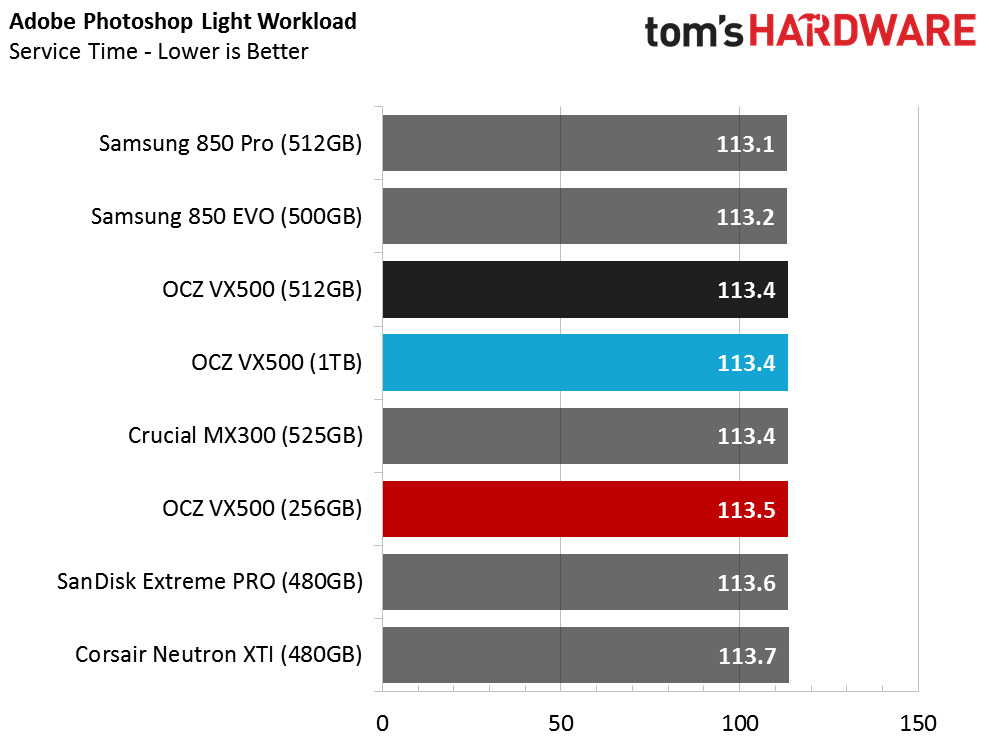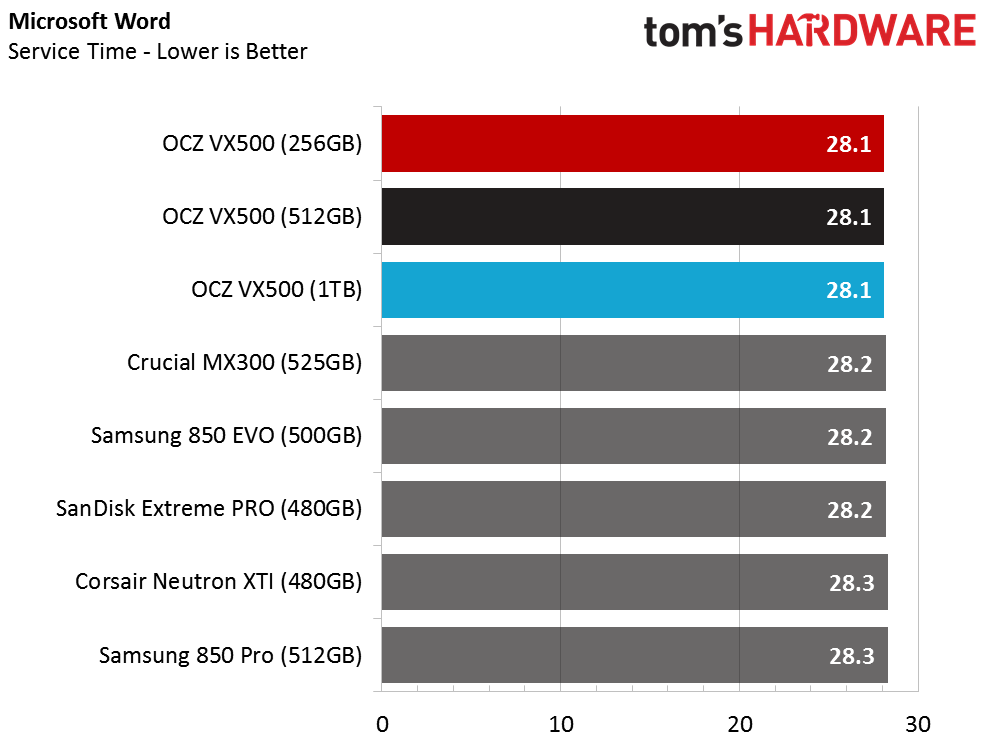Toshiba OCZ VX500 SSD Review
Why you can trust Tom's Hardware
Application Performance
PCMark 8 Real-World Software Performance
For details on our real-world software performance testing, please click here.










Many of the tests on the previous page, which highlight lower random read and write performance, would lead us to expect disappointing application performance with the Toshiba OCZ VX500 series. We often state that a consumer SSD can't deliver exceptional real-world performance without 9 or 10,000 random read IOPS at QD1. The VX500, like many of Toshiba's client SSDs, is the exception. We've asked Toshiba what the secret sauce is, but it doesn't want to reveal the entire recipe. The innovative LBA mapping technology is likely the key performance-boosting ingredient for real-world applications.
Application Storage Bandwidth
Most of the SSDs in this group are close together with roughly 300 MB/s of application performance (averaged results). It's important to remember that the lightest workloads (shown above) differ slightly from the moderate and heavy workloads. These results come from testing when there isn't a lot of data on the flash, so it represents early-life SSD performance. Next, let's look at the heavier workloads when the drive is full of data.
PCMark 8 Advanced Workload Performance
To learn how we test advanced workload performance, please click here.



Several factors play into how an SSD performs late in its lifecycle. The amount of data on the flash, what you ran last, and how long the drive has been at rest all contribute to the performance of your storage system. We control our test environment with automated scripts, but your computer is a dynamic environment.
The charts are full with the fastest consumer SATA SSDs available. The VX500 series holds up well against the premium products. The spoiler remains the same as year's past; the Samsung 850 EVO 500GB. It costs just a few dollars more than the VX500's MSRP, so OCZ will need to work on making its new series a little more attractive.
Get Tom's Hardware's best news and in-depth reviews, straight to your inbox.
Total Service Time



During moderate workloads, the 850 EVO and Extreme Pro still obliterate the other premium SSDs in the service time tests. The VX500 would perform better if OCZ armed it with more performance-increasing DRAM. The design has positive and negative aspects, but here we see the performance impact of going DRAMless.
Notebook Battery Life


We have not tested some of the drives (used in the other charts) with our new Lenovo Y700 notebook and MobileMark 2014.5 software. We've included the SK hynix SL308 because it has the best performance we have measured on this system, but the chart is missing the Extreme Pro and 850 Pro. The other drives appear on the list, though.
The VX500 SSDs all fare well in this test. The 1TB model delivers the best system responsiveness, but the additional power for the NAND die stack and DRAM package combine to chew eight minutes off the battery time.
MORE: Best SSDs
MORE: Latest Storage News
MORE: Storage in the Forums
Current page: Application Performance
Prev Page Comparisons And Synthetic Benchmarks Next Page Conclusion
Chris Ramseyer was a senior contributing editor for Tom's Hardware. He tested and reviewed consumer storage.
-
Dan2357 Hey Tom's (&Chris) great work with the ssd reviews! Between this and the PM961 review yesterday you guys are really putting out the sort of content I come here to see. Just wanted to say thanks and keep it up!Reply -
Zaxx420 Like many others, I cut my teeth on Ocz drives back 'in the day'...lol Learned a lot of what I know about SSDs on their once awesome community forum. They had the balls to light the way for everyone else when SSDs were in their infancy. And ofc being first carries risks...Ocz took a beating trying to sort out Sandforce's firmware nightmare(s) but ultimately someone had to take one for the team. I'd hate to see the Ocz name and more so the Ocz spirit get absorbed into obscurity. Fingers crossed that Ocz can come out guns blazin' when Tosh finally gets BiCS to market. Lord knows they have the resources to duke it out with Samsung at the top but as it sits they are more focused on the more lucrative enterprise market.Reply -
ssdpro In defense, consumers that feel "No 3D, no sale" are victims of marketing magic. You will never experience the difference between planar mlc and "3D" in a high performing SATA device.Reply
But the negative, quoted directly from the article: "I really hope the OCZ portfolio doesn't turn into a rebranded version of Toshiba's OEM and retail products with a new package, sticker and software access. Is this what OCZ has become?"
At this point, it appears that is what it HAS become. Also, as of right now, from the moment this review and others went live OCZ still hasn't listed this product on their website (will change I am sure but sums up their organization). -
Design1stcode2nd Maybe I'm missing something but the real world application graph is what I'm focusing on. It just confirms for me that your average user or gamer will see no real difference in a SATA SSD so go for a TLC or 3D TLC version. I'm probably going to end up with a Trion 150, I just don't see the need to go with an 850 or 850 pro for my use case. By the time the warranty runs out I'll likely have a new Mobo, CPU and be using NVME M/2 anyway. It will also probably be larger capacity for less money as well.Reply -
Modus27 Given the barely noticeable real world differences, I'd take this over Samsung 850 EVO at current MSRP just based on endurance. How did that not make it into a PRO, when you said that was only advantage it had?Reply -
abbadon_34 5 Year warranty? Sold.Reply
In this time dwindling warranties (my recent 8TB Seagate has a 1 year warranty) and the warning given by Kevin Chen about DRAMless going to 12 months this is music to my ears and solid belief in their products.
http://www.tomshardware.com/news/kevin-chen-adata-ssd-industry,32050.html -
mapesdhs I know this review naturally focuses on newer products, but it would be nice to include a couple of older OCZ mainstream models, and even an older top-end model, just to see whether "OCZ" products really have improved compared to what was current not that long ago. Any chance you could add an Arc 100, Vector, Vertex4? Sometimes I feel that SSD reviews tend to do what happens in GPU reviews, not enough comparison across historial timelines to show what the long term trends really are.Reply
Alas, in this case, once again I think price is going to be the deciding factor, and OCZ's more recent products have been consistently too expensive. Shame really, I bought a lot of their older models and am very happy with them, but after the Arc came out their pricing just went up and up, to the point where typical sellers had the Arc 100 listed for more than an 850 EVO, which is nuts. Many never bothered listing the Vector 180 at all.
Btw Chris, please fix those graphs! ;D
Ian. -
CRamseyer I'm limited by how much space I have for the charts. 8 Products is the max for the charts. I would love to increase the comparison depth but I can't. I have nearly ever consumer SSD released since this category started. I would love to release a set of charts with hundreds of drives.Reply -
TMRichard Chris, what I would be really interested in seeing with your test data is an interactive 'chart' which allows us to select the drives want to compare it to. Even if it still maxes out at 8 items that would be more that sufficient. I know there are other sites that will allow us to do this but I would like to know I'm using a reliable, trustworthy set of test data so I can make an informed decision on the item.Reply -
mapesdhs Reply18595925 said:I'm limited by how much space I have for the charts. 8 Products is the max for the charts. I would love to increase the comparison depth but I can't. I have nearly ever consumer SSD released since this category started. I would love to release a set of charts with hundreds of drives.
Perhaps a different chart format? Or a selectable list as TMRichard describes?
Ian.
